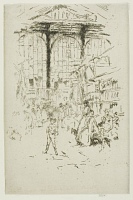KEYWORD
children, clothing, interior, market, people, stall.
TITLE
Variations on the title are as follows:
'
Exchange No. 2 ' (1887/1888, Whistler).
3
'
The Clothes Exchange, Houndsditch, London / (The Jews' Quarter)' (1889,
Charles Lang Freer (1856-1919)).
4
'
Exchange No. 2 - [Hounsditch] ' (1890/1892,
Beatrice Whistler (1857-1896)).
5
'
Clothes Exchange (No. 2)' (1893, World's Columbian Exposition).
6
'
Clothes Exchange No. 1' (1900,
Caxton Club).
7
'
Clothes-Exchange, Houndsditch. No. 2' (1909,
Howard Mansfield (1849-1938)).
8
'
Clothes-Exchange, No. 2' (1910,
Edward Guthrie Kennedy (1849-1932))
9
'
Clothes-Exchange, Houndsditch, No. 2' is the preferred title, coming after
Clothes-Exchange, Houndsditch. No. 1
[358]. Houndsditch is the usual spelling of the area in London's East End although Hounsditch is also used.
DESCRIPTION
An interior view of a tall iron-framed, glass-walled market. At the back are two slender columns, supporting three round arches, below horizontal beams and a pitched roof. A crowd of people are in the corridor between stalls selling clothes. Clothes are displayed on racks and hung from hooks above the stalls. At the centre, near the front, a boy stands with his left hand in his pocket, and at right a young woman is standing and three women are seated round one of the stalls.
SITE
The Clothes Exchange was in Houndsditch in the East End of London. The proprietors were Myers and Abrahams. Henry Mayhew in London Labour and the London Poor described the recycling of every scrap of clothing by Londoners:
'the Old Clothes exchange of the Jewish quarter of London, in the extent and order of its business, is unequalled .
... until the last few years, the trade in old clothes used to be carried on entirely in the open air ... in ... the Petticoat-lane district. ...
Mr. L. Isaac, the present proprietor, purchased the houses which then filled up the back of Phil’s-buildings, and formed the present Old Clothes Exchange. This was eight years ago.
' (that is, in 1843). 10
10: Henry Mayhew, London Labour and the London Poor, London 1851.
'Of Old Clothes Exchanges there are now two, both adjacent, the first one opened by Mr. Isaac being the most important. This ... is the mart to which the collectors of the cast-off apparel of the metropolis bring their goods for sale. The goods are sold wholesale and retail ...
The difference between the first and second class of buyers... is really that of the merchant and the retail shopkeeper. The one buys literally anything presented to him ... for the supply of the wholesale dealers ... The other purchases what suits his individual trade, and is likely to suit regular or promiscuous customers.
In another part of the same market is carried on the retail old clothes trade to any one - shop-keeper, artisan, clerk, costermonger, or gentlemen . ...
The second Exchange, which is a few yards apart from the other is known as Simmons and Levy's Clothes Exchange, and is unemployed ... except in the mornings. The commerce is then wholesale, for here are sold collections of unredeemed pledges in wearing apparel, consigned there by the pawnbrokers, ... In the afternoon the stalls are occupied by retail dealers.' 11
11: Henry Mayhew, London Labour and the London Poor, London 1851.
J. Ewing Ritchie elaborated on Mayhew's description:
'the Old Clothes Exchange ... was erected some dozen years ago by one of the leading merchants in the old clothes line. A small entrance fee is demanded. ... If it be Sunday ... The scrambling ... and pushing, and driving are dreadful. ... In the week day, and you are a seller, you are soon pounced on by the Jews hungering and thirsting after bargains ... If you are a buyer, you are quite as quickly attacked. ... the Exchange, as it is termed, is not a building of a very gorgeous style of architecture ... Near is the "City Clothes Emporium," and all the streets and alleys in the neighbourhood are similarly occupied.' 12
12: J. Ewing Ritchie, Here and there in London, W. Tweedie, London, 1859, pp. 117-123, on-line at http://www.mernick.co.uk (accessed 2008).
In a later description, Mayhew & Binny commented: 'Some dozen years ago, one of the Hebrew merchant dealers in old clothes purchased the houses at the back of Phil's Buildings - a court leading out of Houndsditch, immediately facing St Mary Axe, and formed the present market, now styled the "Old Clothes Exchange,"' 13 They added that 'About three or four o'clock in winter, and four or five in summer, are the busiest periods.' 14
13: H. Mayhew & J. Binny, The Criminal Prisons of London and Scenes of London Life, London, 1862, pp. 39-40.
14:
ibid.

